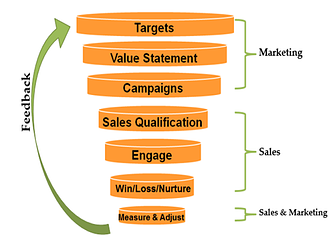
The dynamic between sales and marketing activities has taken a vast jump as a result of the expansion of internet and digital marketing.
It’s 2021 and the world of B2B marketing and sales has been online for a while now. What’s another thing that’s been going on for a while? Disconnected sales and marketing teams.
You’ve probably invested in tech tools like a CRM and marketing automation software to help your teams, but are they being used to full advantage? Just because the technology is out there doesn’t mean sales and marketing are instantly more efficient and aligned (or they know what each other is up to, or why). It’s necessary to spend time gathering and analyzing the data and coming up with effective processes to make the most of these tools. Otherwise, you’re spending a lot of money but still feeling like something is disconnected.
If you’re wondering how to align sales and marketing, here are some tips for keeping them connected at your organization.
Get Maximum Value from Your Marketing Automation Tools
Marketing automation tools are providing information and data that is important and necessary for today’s sales because they track page visits, click rates, downloads, and all the interaction prospects have with your site. Since your site forms their first impression, marketing and usage data must be used to provide leverage and create inroads with tailored content.
You can further influence that activity with automated workflows. For example, trigger an email template when a prospect makes a certain action like downloading an ebook, or set up automatic call back reminders for sales reps to follow up with webinar attendees one week later. Then, track their activity again and the process repeats.
But to get the most out of marketing automation, early on you’ll need to determine exactly what activity to track, why you’re tracking it, and what you’ll do as a result of the data. For example, you might decide that if there is “enough interest” from prospects, you will create an ebook or webinar on your new line of stainless steel fasteners. You must define “enough interest” based on web and email activity and the other piece of the puzzle: sales insight.
Let Sales Expertise Shine Through in Content
Thanks to the internet prospects are highly self-educated about your products and have very specific and detailed questions by the time they interact with sales reps. It changes the traditional sales role but provides an excellent opportunity for reps to pinpoint the gaps in prospect knowledge, develop expertise about each industry and company and their daily operations, and dig into what makes them hesitant. This level of detail is excellent fodder for relevant and targeted content, but only if sales shares what they know with marketing.
Marketing must ask sales to help with defining the target audiences and creating a value proposition that resonates with each audience. Here are some useful things to know from the sales perspective:
- Typical questions prospects ask
- What they already know and what’s still missing
- What information wins them over, and what turns them off
- Common misconceptions about your products
- Critical issues and concerns in their industry
- Aspects of their operations where your product brings great value
- How competitors are marketing to these same prospects
By sharing marketing data with sales and keeping them involved in the content creation process, your web presence, social media, blogs, and product demos will be more useful and relevant to prospects.
Nurture Prospects to Keep them Advancing
It’s possible to simplify prospect nurturing somewhat with automated workflows, a documented process for handoffs, shared advancement criteria, and policy of communication. But even with automated email replies and other time savers, there must be time built into the schedule to manage your pipeline and nurture prospects.
For example, if you know a prospect’s budget planning takes place in the fall, you can’t wait until late summer to make your pitch. Stay in touch through spring and summer to cover all the possible questions and offers so they have all the information needed for decisive action when the time comes.
Historically, when sales and marketing are working in silos, sales may not realize that effective nurturing will require their close attention to email correspondence, web activity, and reaction time. Planning for this is just as critical today as it was in years past, and schedules need to reflect this important step. This is often a source of disconnection between sales and marketing: marketing wonders why sales is unresponsive and sales feels expectations are too stringent for the sales cycle.
Is it more efficient to focus only on the most promising opportunities? We all know that some opportunities have more potential than others, but it’s worth tracking the “warm” leads as well as the “hot.” Some may become ready to buy after a period of nurturing, so keep tabs on them in your CRM or marketing automation system – don’t just reserve it for the strongest opportunities. Here’s where automated nurturing shines: use automated workflows to schedule a series of emails depending on how you’ve scored opportunities their activity (website clicks, email opens, responses to sales calls). The key is for marketing and sales to keep an eye on that data and plan for some nurturing in response.

Revisit and Refine the Campaign
Even after a campaign is underway, marketing and sales must come back to the table to triage the results. Gathering data makes it easier to track what was achieved objectively and look for areas that might need to be changed.
Sales and marketing should ask these and other questions to assess the performance of the campaign to pinpoint gaps and make adjustments:
- Where are prospects getting lost or stuck?
- Is there critical information they’re not receiving?
- Are nurturing emails being opened?
- Has a key competitor doubled down on a similar campaign to yours?
- Is your value proposition convincing?
- Are you targeting the right personas and roles?
The truth is, very few campaigns are a home run on the first swing. They require phases, understanding, and grooming, like all good policies. They take time to refine – and with collaborative effort, the desired end will be achieved – a successful and, most importantly, measurable business development campaign.
Sales and marketing roles are inherently connected by prospects and leads – it’s time to make sure they’re using the tools and data they already have to grow the organization. Let us know how it’s going for you – we’re always here to help.
Editor’s note: This blog has been updated for accuracy and comprehensiveness.
